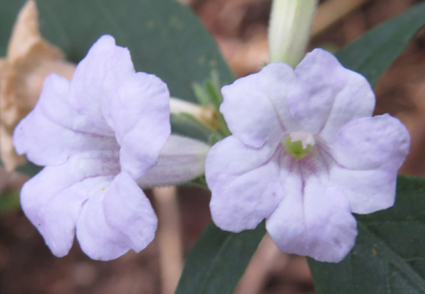Abstract
Ruellia umbrosa, a new species from the riparian forest in the lowlands of the Goiás state, is described and illustrated. It is similar to the South American species R. erythropus and R. epallocaulos by the decumbent stems rooting at nodes, solitary flowers in the axils of the upper leaves, and capsules with eight or more seeds, but differs in having white or slightly mauve corollas, absence of bractlets, corolla with tube and throat similar in size, calyx with 5 lobes equal or slightly subequal with dense trichomes, and larger number and size of the seeds by capsules, among other characters. It grows in an environment under strong anthropogenic pressure in a small area and, therefore, was classified as Critically Endangered.
References
<p>Benoist, R. (1939) Nouvelles Acanthacées Malgaches. <em>Notulae Systematicae</em> 8 (3): 135–161.</p>
<p>Braz, D.M., Freitas Azevedo, I.H. & Tripp, E.A. (2020) A new species and lectotypification in <em>Ruellia</em> (Acanthaceae) from the southeastern Atlantic Forest, Brazil. <em>Systematic Botany</em> 45: 334–339. https://doi.org/10.1600/036364420X15862837791140</p>
<p>Bremekamp, C.E.B. (1938) Acanthaceae. <em>Recueil des Travaux Botaniques Néerlandais</em> 35: 160–164.</p>
<p>Browne, P. (1756) <em>The civil and natural history of Jamaica in three parts.</em> The Author, London. 503 pp.</p>
<p>Chagas, E.C.O. & Lima, J.L.C. (2020) Five new species of <em>Ruellia</em> (Acanthaceae) from the Atlantic Forest of northeastern Brazil. <em>Neodiversity</em> 13: 39–55. https://doi.org/10.13102/neod.131.2</p>
<p>Ezcurra, C. (1993) Systematics of <em>Ruellia</em> (Acanthaceae) in Southern South America. <em>Annals of the Missouri Botanical Garden</em> 80: 787–845. https://doi.org/10.2307/2399931</p>
<p>Ezcurra, C. & Wasshausen, D.C. (1992) New species of <em>Ruellia</em> (Acanthaceae) from southern South America. <em>Brittonia</em> 44: 69–73. https://doi.org/10.2307/2807445</p>
<p>Ezcurra, C. (1998) A new species of <em>Ruellia</em> (Acanthaceae) from Paraguay. <em>Brittonia</em> 50: 339–342. https://doi.org/10.2307/2807777</p>
<p>Fernandes, U.G., Kameyama, C., Ezcurra, C., Indriunas, A. & Pessoa, C.S. (2020) <em>Ruellia</em> in Flora do Brasil (2020) Jardim Botânico do Rio de Janeiro. Available from: http://floradobrasil.jbrj.gov.br/reflora/floradobrasil/FB4204 (accessed 10 January 2022)</p>
<p>IUCN Standards and Petitions Subcommittee (2017) Guidelines for using the IUCN Red List Categories and Criteria. Version 13. Prepared by the Standards and Petitions Subcommittee. Available from: http://www.iucnredlist.org/documents/RedListGuidelines. pdf (accessed 8 January 2022)</p>
<p>Jussieu, A.L. (1789) <em>Genera Plantarum secundum ordines naturales disposita, juxta methodum in horto region parisiense exaratam</em>. Herissant, Paris, 498 pp.</p>
<p>Lindau, G. (1895) Acanthaceae. <em>In:</em> Engler, A. & Prantl, K. (Eds.) <em>Die Natürlichen Pflanzenfamilien</em> 4 (3b). Wilhelm Engelmann, Leipzig. pp. 274–354.</p>
<p>Linnaeus, C. (1753) <em>Species Plantarum</em> 1. Laurentii Salvius, Stockolm, 560 pp. https://doi.org/10.5962/bhl.title.669</p>
<p>Nees Von Esenbeck, C.G. (1847) Acanthaceae. <em>In:</em> von Martins, K.F.P. & Eicliler, A.G. (Eds.) <em>Flora Brasiliensis</em> 9. F. Fleischer, Lipsiae, pp. 1–164.</p>
<p>QGIS development team (2016) QGIS Geographic Information System. Open Source Geospatial Foundation Project. Available from: http://www.qgis.org/ (accessed 3 November 2021)</p>
<p>Reis, A.S., Kameyama, C. & Gil, A.S.B. (2017) <em>Ruellia</em> anamariae, a new species of Acanthaceae from northern Brazil. <em>Phytotaxa</em> 327: 276–282. https://doi.org/10.11646/phytotaxa.327.3.7</p>
<p>Ribeiro, J.F. & Walter, B.M.T. (2008) As principais fitofisionomias do Bioma Cerrado. <em>In:</em> Sano, S.M., Almeida, S.P. & Ribeiro, J.F. (Eds.) <em>Cerrado: ecologia e flora. </em>Embrapa Cerrados, Planaltina, pp. 151–212.</p>
<p>Schmidt-Lebuhn, A.N. & Tripp, E.A. (2009) <em>Ruellia</em> saccata, a new species of Acanthaceae from Bolivia. <em>Novon</em> 19: 515–519. https://doi.org/10.3417/2008021</p>
<p>Thiers B (2022 [continuously updated]) Index Herbariorum: A global directory of public herbaria and associated staff. New York Botanical Garden’s Virtual Herbarium. Available from: http://sweetgum.nybg.org/ih/ (accessed 7 April 2022)</p>
<p>Tripp, E.A. (2007) Evolutionary relationships within the species-rich genus <em>Ruellia</em> (Acanthaceae). <em>Systematic Botany</em> 32: 628–649. https://doi.org/10.1600/036364407782250625</p>
<p>Tripp, E.A. & Darbyshire, I. (2017) Phylogenetic Relationships among Old World <em>Ruellia</em> L.: A New Classification and Reinstatement of the Genus Dinteracanthus Schinz. <em>Systematic Botany</em> 42: 470–483. https://doi.org/10.1600/036364417X695961</p>
<p>Tripp, E.A. Daniel, T.F., Fatimah, S. & McDade, L.A. (2013) Phylogenetic relationships within Ruellieae (Acanthaceae) and a revised classification. <em>International Journal of Plant Sciences</em> 174: 97–137. https://doi.org/10.1086/668248</p>
<p>Wasshausen, D.C. (1992) New species of <em>Ruellia</em> (Acanthaceae) from the Venezuelan Guayana. <em>Novon</em> 2: 139–148. https://doi.org/10.2307/3391675</p>
<p>Wasshausen, D.C. & Wood, J.R.I. (2003) Notes on the genus <em>Ruellia</em> (Acanthaceae) in Bolivia, Peru and Brazil. <em>Proceedings of the Biological Society of Washington</em> 116: 264–274.</p>
<p> </p>


